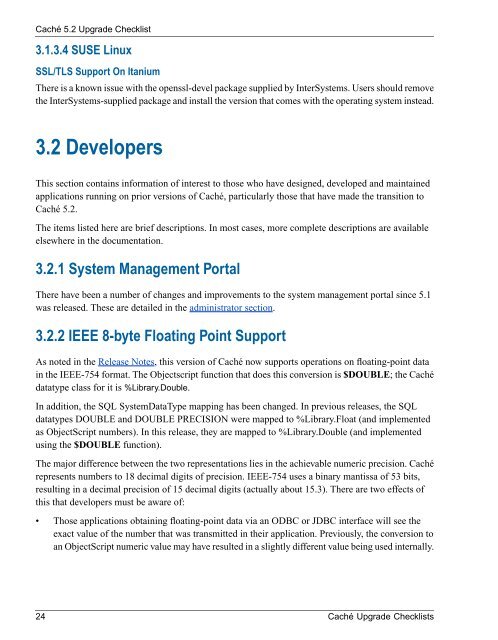Caché Upgrade Checklists - InterSystems Documentation
Caché Upgrade Checklists - InterSystems Documentation
Caché Upgrade Checklists - InterSystems Documentation
You also want an ePaper? Increase the reach of your titles
YUMPU automatically turns print PDFs into web optimized ePapers that Google loves.
<strong>Caché</strong> 5.2 <strong>Upgrade</strong> Checklist<br />
3.1.3.4 SUSE Linux<br />
SSL/TLS Support On Itanium<br />
There is a known issue with the openssl-devel package supplied by <strong>InterSystems</strong>. Users should remove<br />
the <strong>InterSystems</strong>-supplied package and install the version that comes with the operating system instead.<br />
3.2 Developers<br />
This section contains information of interest to those who have designed, developed and maintained<br />
applications running on prior versions of <strong>Caché</strong>, particularly those that have made the transition to<br />
<strong>Caché</strong> 5.2.<br />
The items listed here are brief descriptions. In most cases, more complete descriptions are available<br />
elsewhere in the documentation.<br />
3.2.1 System Management Portal<br />
There have been a number of changes and improvements to the system management portal since 5.1<br />
was released. These are detailed in the administrator section.<br />
3.2.2 IEEE 8-byte Floating Point Support<br />
As noted in the Release Notes, this version of <strong>Caché</strong> now supports operations on floating-point data<br />
in the IEEE-754 format. The Objectscript function that does this conversion is $DOUBLE; the <strong>Caché</strong><br />
datatype class for it is %Library.Double.<br />
In addition, the SQL SystemDataType mapping has been changed. In previous releases, the SQL<br />
datatypes DOUBLE and DOUBLE PRECISION were mapped to %Library.Float (and implemented<br />
as ObjectScript numbers). In this release, they are mapped to %Library.Double (and implemented<br />
using the $DOUBLE function).<br />
The major difference between the two representations lies in the achievable numeric precision. <strong>Caché</strong><br />
represents numbers to 18 decimal digits of precision. IEEE-754 uses a binary mantissa of 53 bits,<br />
resulting in a decimal precision of 15 decimal digits (actually about 15.3). There are two effects of<br />
this that developers must be aware of:<br />
• Those applications obtaining floating-point data via an ODBC or JDBC interface will see the<br />
exact value of the number that was transmitted in their application. Previously, the conversion to<br />
an ObjectScript numeric value may have resulted in a slightly different value being used internally.<br />
24 <strong>Caché</strong> <strong>Upgrade</strong> <strong>Checklists</strong>

















